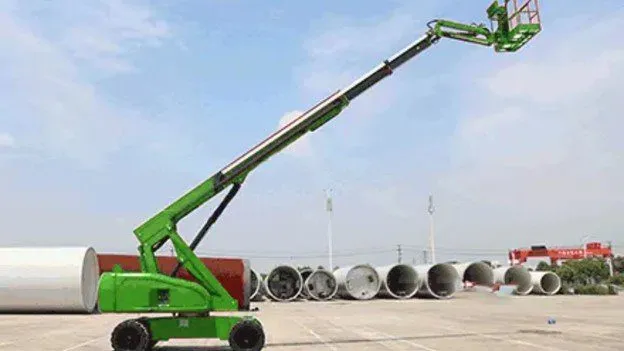Tech
Elevated Efficiency: A Comprehensive Guide to Using Boom Lifts on Modern Worksites
Published
3 months agoon
By
Prime Star
Introduction
Reaching elevated areas safely and efficiently is a critical requirement in many industries, especially construction, maintenance, logistics, utilities, and event production. Whether it’s installing lighting on a high ceiling, inspecting roofing, painting tall structures, or trimming trees, working at heights presents unique challenges. Traditional ladders and scaffolding may not always provide the reach, flexibility, or safety required. That’s where boom lifts become invaluable.
A boom lift, sometimes referred to as a cherry picker or man lift, is a type of aerial work platform (AWP) that offers both vertical and horizontal reach. It allows workers to access difficult-to-reach areas with precision and stability. But purchasing this equipment can be costly and impractical for many businesses, especially if it’s only needed temporarily. This is where boom lift rental becomes the smarter, more flexible option.
This article delves into how boom lifts work, the types available, safety practices, key benefits of using them, and why renting one might be the best choice for your operation.
What Is a Boom Lift?
A boom lift is a mechanized platform used to lift workers and tools to high elevations, both vertically and outward horizontally. Unlike scissor lifts that move straight up, boom lifts come with an extendable arm (or “boom”) that can reach over obstacles and into hard-to-access spaces.
Boom lifts typically consist of a base, a hydraulic or electric-powered boom arm, and a platform or bucket at the end where personnel can work. The operator can maneuver the lift from within the platform, allowing for precise positioning even at extreme heights.
These lifts are used in a wide variety of indoor and outdoor applications, from changing lights in high ceilings to inspecting tall infrastructure like bridges or towers.
Types of Boom Lifts
Choosing the right boom lift depends on the type of work you’re doing, how high you need to go, and the surface conditions. Below are the most common types of boom lifts available:
1. Articulating Boom Lifts
Also called knuckle booms, these lifts have jointed arms that bend, allowing the operator to navigate around obstacles and tight spaces. They’re excellent for confined areas or sites with structures that block direct paths.
2. Telescopic Boom Lifts
Sometimes called straight booms or stick booms, these lifts have a straight extendable arm that provides maximum horizontal and vertical reach. They’re ideal for applications requiring access to tall buildings or structures in open environments.
3. Trailer-Mounted Boom Lifts
These are towable lifts that can be hitched to a vehicle and transported easily. They’re perfect for short-term use, especially when mobility is key, and typically have stabilizing outriggers for balance.
4. Spider Lifts
Spider lifts feature multi-leg stabilizers (like spider legs) and are extremely compact and lightweight. They are suited for rough terrain, delicate flooring, or areas with limited access. Their ability to fold and fit through narrow openings makes them useful indoors and outdoors.
Advantages of Using Boom Lifts
Boom lifts offer multiple advantages that make them indispensable on many job sites:
1. Versatility
With both vertical and horizontal reach, boom lifts can access areas that are unreachable by scissor lifts or ladders. This makes them useful in complex environments like tall buildings, bridges, or dense industrial sites.
2. Enhanced Safety
Modern boom lifts are built with safety features such as fall arrest anchor points, guardrails, emergency stop buttons, and tilt alarms. These features reduce the risk of falls and other job-site hazards.
3. Precision Access
Operators can control the platform’s movement from within the basket, allowing for exact positioning. This is critical when working in tight spaces or around delicate structures.
4. Time Efficiency
Boom lifts allow workers to complete elevated tasks faster, reducing downtime and improving productivity. Because they’re mobile and maneuverable, they also reduce the time needed to reposition the platform.
5. Heavy Lifting Capacity
Most boom lifts can carry not only one or two workers but also tools, equipment, and materials, eliminating the need for separate lifting systems.
When to Consider Boom Lift Rental
While owning a boom lift may be beneficial for companies that use them daily, for many others, boom lift rental offers practical and financial benefits. Here’s when renting makes the most sense:
a. Short-Term Projects
If your project lasts only a few days or weeks, renting avoids the large capital outlay of purchasing. There’s no need to worry about depreciation or long-term storage.
b. Specialty Applications
Not all jobs require the same type or size of lift. Renting allows you to select the right equipment for each specific project without being locked into a single machine.
c. Maintenance-Free Operation
Rental providers maintain their fleets regularly. This means you get equipment that is up-to-date, fully functional, and compliant with safety standards—without the headache of upkeep.
d. Access to Modern Technology
Technology in aerial work platforms is continually improving. Renting gives you access to the newest models with advanced safety features and better fuel efficiency.
e. Budget Flexibility
Renting turns a large capital expense into a manageable operating cost. For businesses needing to maintain cash flow, this can be a huge advantage.
How to Choose the Right Boom Lift
Selecting the right lift involves several key considerations:
- Height Requirements: Know the maximum height you need to reach. Telescopic lifts typically offer higher vertical reach than articulating models.
- Worksite Conditions: Consider surface type (paved vs. uneven terrain), overhead obstructions, and access space.
- Load Capacity: Estimate the weight of personnel, tools, and materials to ensure the platform can handle the load.
- Power Source: Electric lifts are best for indoor work, offering quiet, emission-free operation. Diesel or gas models are more suited for outdoor and heavy-duty tasks.
- Mobility Needs: If your job requires frequent relocation of the lift, consider models with better transportability or even trailer-mounted options.
Safety Best Practices
Operating a boom lift involves risks that can be mitigated with proper safety procedures:
1. Training and Certification
Operators must be trained and certified according to industry standards. Understanding how to operate the lift, perform inspections, and respond to emergencies is critical.
2. Pre-Use Inspections
Always check the lift before use. Inspect for hydraulic leaks, tire pressure, structural damage, and test all controls. If anything appears off, report it to your rental provider immediately.
3. Use Personal Protective Equipment (PPE)
Operators should wear hard hats, harnesses with lanyards (connected to designated anchor points), and non-slip boots. Some jobs may also require eye and hearing protection.
4. Secure the Area
Mark off the work area with cones or barricades to prevent bystanders from entering a hazardous zone. This is especially important in high-traffic locations.
5. Monitor Weather Conditions
Avoid operating boom lifts in high winds, lightning, or slippery conditions. Even mild winds can destabilize extended lifts, especially at higher heights.
Cost of Boom Lift Rental
The cost of boom lift rental varies based on lift type, height, rental duration, and region. Here’s a general breakdown:
| Lift Type | Daily Rate | Weekly Rate | Monthly Rate |
| Articulating Boom (30-45 ft) | $250 – $400 | $700 – $1,000 | $2,000 – $3,000 |
| Telescopic Boom (60-80 ft) | $400 – $600 | $1,000 – $1,600 | $3,000 – $4,500 |
| Trailer-Mounted Boom | $150 – $300 | $500 – $800 | $1,500 – $2,000 |
Note: Additional costs may include delivery/pickup fees, fuel charges, damage waivers, and operator training (if required).
Tips for a Successful Rental Experience
To get the most value from your boom lift rental, consider the following:
- Plan Ahead: Know the exact specifications you need and reserve the lift early, especially during peak seasons.
- Clarify Rental Terms: Read the rental agreement carefully. Understand terms related to damage, late returns, and insurance.
- Inspect on Delivery: Walk through a pre-use checklist and document the condition of the equipment to avoid disputes.
- Train Your Crew: Ensure everyone involved understands how to use the equipment and follow safety protocols.
Conclusion
Boom lifts are essential tools for modern jobs that involve working at height. With their impressive reach, stability, and maneuverability, they are unmatched in terms of flexibility and efficiency. But buying one isn’t always the best solution—especially for businesses with limited or occasional needs.
That’s where boom lift rental becomes a cost-effective, risk-free way to access cutting-edge equipment without the burdens of ownership. Whether you’re working on a high-rise, inspecting electrical lines, or performing building maintenance, renting a boom lift offers the right combination of safety, capability, and convenience.
By choosing the right lift and following best practices, you’ll not only get the job done more efficiently—you’ll do it safely, economically, and professionally.
You may like


Why Companies Worldwide Are Hiring Power BI Developers

Experience Pure Android Gameplay with MuMuPlayer Emulator

A Guide To Solar PV For Homeowners

How to Convert a Historic Building into a Hotel: a 2025 Guide

How You Can Integrate AI into Your Small Business For Faster Growth

File Recovery on Android: Myths vs. Facts

Cooler, Safer, Clearer: Why Quality Window Tint Is a Smart Upgrade in 2025

How Medium-Sized Businesses Actually Handle Their Books

Best Travel Vacuum Bags: Pack More and Worry Less with Vacbird Storage Bags

Start Your Morning Right: The Real Benefits of Himalayan Pink Salt and Lemon Water

Carol Kirkwood’s Journey: Her Real Age, Husband, Career, and More

Revolutionizing Healthcare: The Emergence of AI-Driven Analytics

How Machine Learning and AI are Redefining the Future?

Aliza Barber: Meet Lance Barber’s Wife, Age, Life, Profile, Career and Net Worth

Evelyn Melendez: Jordan Knight’s Wife Bio, Marriage, Family, Career and Net Worth

Ilan Tobianah Biography: Family, Marriage, Lifestyle, Career and Net Worth

Who was Alice Marrow? Everything to Know About Ice-T’s and His Mother

King Von’s Autopsy Report: The Truth Behind the Tragic Death

Meet Otelia Cox: The Supportive Wife of Tony Cox – A True Fairy Tale Romance

Tea Leoni and Tim Daly Split – A Closer Look at Their Relationship and Breakup

Why Companies Worldwide Are Hiring Power BI Developers

Experience Pure Android Gameplay with MuMuPlayer Emulator

A Guide To Solar PV For Homeowners

How to Convert a Historic Building into a Hotel: a 2025 Guide

How You Can Integrate AI into Your Small Business For Faster Growth

File Recovery on Android: Myths vs. Facts

Cooler, Safer, Clearer: Why Quality Window Tint Is a Smart Upgrade in 2025

How Medium-Sized Businesses Actually Handle Their Books

Best Travel Vacuum Bags: Pack More and Worry Less with Vacbird Storage Bags

Start Your Morning Right: The Real Benefits of Himalayan Pink Salt and Lemon Water
Category
Trending
-

 News3 months ago
News3 months agoCarol Kirkwood’s Journey: Her Real Age, Husband, Career, and More
-

 Health2 years ago
Health2 years agoRevolutionizing Healthcare: The Emergence of AI-Driven Analytics
-

 Technology2 years ago
Technology2 years agoHow Machine Learning and AI are Redefining the Future?
-

 Celebrity2 years ago
Celebrity2 years agoAliza Barber: Meet Lance Barber’s Wife, Age, Life, Profile, Career and Net Worth
